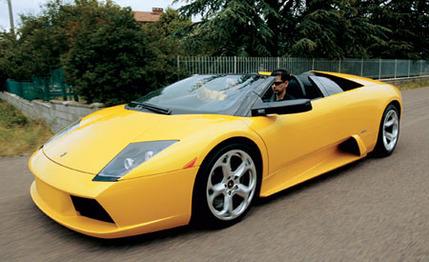
 First Drive Review
First Drive Review
Compared with the nearly practical and potential-daily-driver Gallardo, the larger V-12 Murciélago still has strong ties to the legendary and hyperexotic pinup Countach that helped Lamborghini survive financially through the '70s and '80s. Whereas most sports cars are the automotive equivalent of superhero costumes, the Murciélago roadster, like the Countach, goes beyond that by adding a codpiece. The Murciélago droptop is more like the fictional Durango 95 that Malcolm McDowell's character, Alex, and his "droogs" use as wheels as they terrorize the countryside and sharpen up at the milk bar in Stanley Kubrick's film A Clockwork Orange. That open-air Durango 95 resembled a Can-Am race car—futuristic, impossibly low-slung, reeking of antisocial irresponsibility.
The Murciélago is similarly otherworldly and sinister. There's nothing else like it on the automotive landscape, and something happens deep in your brain when you drive one. The voice of reason that keeps you from quitting your job or wearing pinky rings gives way to an ultra-violent, suitcase-throwing gorilla that could care less about job or jewelry. One feels that prolonged usage might require some radical treatment, but in a nod to keeping society on an even keel, Lamborghini will make only about 200 of these a year.
The width and height of the beast are shocking to behold in the flesh. Standing a scant 42.0 inches high with the top removed and stretching to 80.5 inches at its widest point, the roadster is nearly twice as wide as it is tall. Make the climb into the driver's seat through the tiny gap created by the famous scissors doors that have become de rigueur on pimped-out Civics, and you'll be rewarded with a hand-crafted leather interior and a surprising amount of space. Since the open-air Murciélago's interior will be on view to envious passersby, it's been dressed up a bit more than the hardtop version's. The driver's side of the cockpit gets perforated leather on the seats and dashboard, and the passenger gets diaper-soft smooth leather. To add to the uniqueness of the roadster, each side of the interior can be dressed in one of four standard leather colors. And given enough time and money, Lamborghini will dye the leather just about any hue you want. Think it over carefully, because if Lamborghini feels your ability to match colors is less than tasteful, you will be brought in for an intervention. Caution: This may mean you'll suddenly lose your taste for lacquer furniture, silk shirts, and Barry Manilow.
The top is a decidedly unsophisticated device. Essentially a fabric tarp held up by rib-like metal supports and kept in place by a couple of fasteners, it resembles a hairpiece more than a modern convertible top. With it in place, you'll immediately be perplexed by a stern warning not to exceed 100 mph. Huh? Turns out if you venture past the century mark, the top might come off faster than the T-shirt of a drunk sorority girl cruising Bourbon Street. In defense of the toupee-like top, Lamborghini thinks of it as an emergency device in case some unexpected precipitation ruins your chance of claiming in a duPont Registry for-sale ad that your Lambo was never driven in the rain.
It's better to unfasten the top and store it in the trunk so the Murciélago can expose you to the delightful exhaust note of its 6.2-liter V-12. The engine is as much a musical instrument as it is a means of propulsion. Perhaps the best part of this roofless car is that $319,250 buys you a season's pass of exclusive performances. Winding out first and second of the six-speed gearbox (a traditional manual is standard; paddle shifting is a $10,000 option) requires a clear stretch of road. First is good for 77 mph, and second will take you all the way to 110 mph. As one would expect of a 572-hp engine, there is power everywhere, but the V-12 really hits its stride thrustwise and aurally beyond 5000 rpm. A few runs into that zone and a doofus smile of self-satisfaction that would make George Dubya proud will inevitably make its way onto your mug.
To keep this car from feeling limp, Lamborghini strengthens the floor and doorsills with composites. These modifications, along with a new engine cradle and a more rigid windshield frame, keep the roadster largely flex-free. In a nod to safety, there are automatic rollover bars, adapted from those on the Audi A4 cabriolet, that deploy from behind the seats should the Lambo threaten to turn turtle. The factory says these changes add only 33 pounds to the roadster, which raises a skeptical eyebrow, but the droptop still feels stupendously fast.
Sharp-eyed enthusiasts will notice that the convertible wears new one-piece wheels that measure the same 18 inches as the three-piece wheels found on Murciélago coupes. The new wheels allow for larger brake rotors all around and will come standard on coupes in 2005. It's not as if the Murciélago needed larger brakes; we tested one last year that stopped from 70 mph in a scant 155 feet [ C/D, July 2003].
During our blitz through the Italian countryside around Sant' Agata, the convertible proved to be astoundingly civil. Clutch, shifter, and steering effort are as light as you'd find on a Honda Accord, which means that no special skills are required to pilot the Murciélago. To drive one is to understand what McDowell's Alex was talking about when he described the feel of his Durango 95 as "a nice, warm vibraty feeling all through your guttiwuts." It's a miracle the Lambo doesn't come with a government warning, because the feeling is addictive and the withdrawal is painful.